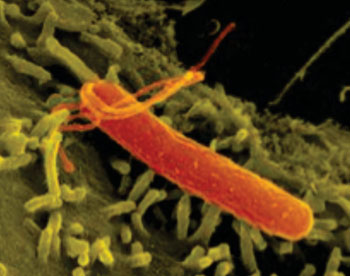Suppression of DNA Repair by H. pylori Paves the Way for Development of Gastric Cancer
By LabMedica International staff writers
Posted on 29 Jun 2015
A team of molecular microbiologists has established what they believe to be the definitive link between Helicobacter pylori infection and the development of gastric cancer.Posted on 29 Jun 2015
Infection with the human pathogen H. pylori is a major risk factor for gastric cancer. However, since the bacterium exerts multiple genotoxic effects, investigators at the Max Planck Institute for Infection Biology (Berlin, Germany) chose to examine how DNA damage accumulated in gastric cells following H. pylori infection.

Image: The stomach bacterium Helicobacter pylori changes the activity of genes in gastric cells (Photo courtesy of Max Planck Institute for Infection Biology).
The investigators utilized a new technique for cultivating cultures of normal human stomach tissue. This material replaced the use of cancer cell lines whose mutated genomes obscured early changes induced by H. pylori.
Results published in the June 11, 2015, online edition of the journal Cell Reports revealed that the activity of several sub-telomeric genes responsible for recognizing and repairing damaged DNA was suppressed during the course of the infection. Infection impaired several host cell DNA repair factors, the extent of which depended on a functional H. pylori cag pathogenicity island (cagPAI). This led to accumulation of a unique DNA damage pattern, preferentially in transcribed regions and proximal to telomeres, in both gastric cell lines and primary gastric epithelial cells. The observed pattern correlated with focal amplifications in adenocarcinomas of the stomach and partly overlapped with known cancer genes.
They authors described their interpretation of the impact of H. pylori infection on host cell DNA by saying, "We thus demonstrate an impact of a bacterial infection directed toward specific host genomic regions and describe underlying characteristics that make such regions more likely to acquire heritable changes during infection, which could contribute to cellular transformation."
Related Links:
Max Planck Institute for Infection Biology













